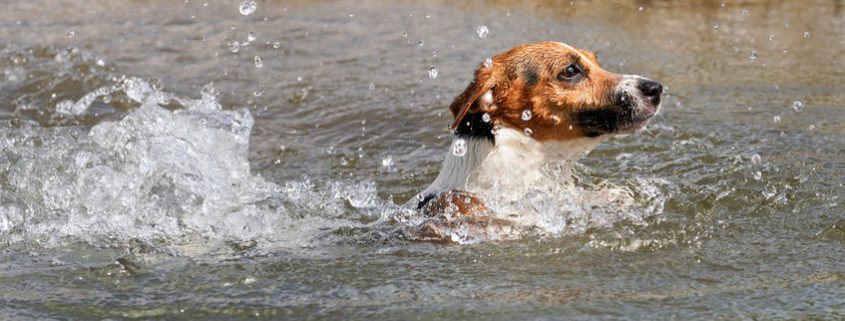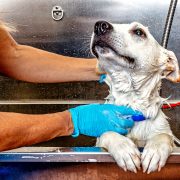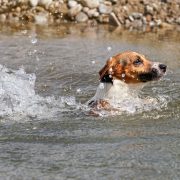Veterinary medicines and the environment
‘In the Spotlight’ features bring together collections of published papers on topics of interest and importance to the veterinary professions.
Papers are chosen for relevance and accessibility, with the full text of articles either being available through the RCVS Knowledge Library, on open access or from other publications to which a significant number of veterinary professionals are likely to have access. This means that there may be relevant evidence that is not included. If you would like assistance in searching for further evidence on this topic you may find the following helpful EBVM Toolkit 2: Finding the best available evidence.
If you would like to suggest a paper for inclusion in one of our published Spotlight features, or a topic for a future Spotlight feature, please email library@rcvsknowledge.org
Veterinary medicines and the environment
Updates 18 November 2024 This paper aimed to assess the contribution of dog swimming to the detection of selected pet ectoparasiticides in aquatic habitats in protected urban green spaces, and to understand dog owners’ knowledge and perceptions of the use of flea and tick treatments and their potential environmental risks. Yoder, L.E. et al. (2024) Dog swimming and ectoparasiticide water contamination in urban conservation areas: A case study on Hampstead Heath, London. Science of The Total Environment, 955, 176686. https://doi.org/10.1016/j.scitotenv.2024.176686 1 February 2024 This paper aimed to estimate the contribution of ‘down the drain’ contamination from washing dogs and their bedding as well as from handwashing following treatment with Fipronil and Imidacloprid. Perkins, R. et al. (2024) Down-the-drain pathways for fipronil and imidacloprid applied as spot-on parasiticides to dogs: Estimating aquatic pollution. Science of The Total Environment, 917, 170175. https://doi.org/10.1016/j.scitotenv.2024.170175.
A paper recently published in Science of the Total Environment has received coverage in both the national and veterinary press, raising concern about the extent to which commonly used parasiticides for companion animals may contaminate the environment. A summary of the paper is available.
Press coverage
- Carrington, D. (2020) Pet flea treatments poisoning rivers across England, scientists find [The Guardian] [online] Available from:
https://www.theguardian.com/environment/2020/nov/17/pet-flea-treatments-poisoning-rivers-across-england-scientists-find [accessed 29/1/2021] - Potential role of flea products in pesticide contamination of rivers [CABI] [online] Available from: https://www.cabi.org/VetMedResource/news/67068 [accessed 29/1/2021]
- Loeb, J. (2020) Contaminated rivers are ‘deeply troubling’. Veterinary Record, 187 (11), pp. 425-425. https://doi.org/10.1136/vr.m4612
References
- Forbes, A. (2021) Environmental risk assessment of veterinary parasiticides used in cattle Livestock 26 (1) pp15 -25 https://doi.org/10.12968/live.2021.26.1.15
Other relevant resources
Further reading
While there is already a wide literature base available regarding the impact of pharmaceuticals on the environment these papers are mostly published in journals that cover toxicology and environmental science. For those who would like to read more about this subject the following may be of interest.
Anthe, M. et al (2020) Development of an aquatic exposure assessment model for Imidacloprid in sewage treatment plant discharges arising from use of veterinary medicinal products. Environmental Sciences Europe, 32, no. 147 (2020). https://doi.org/10.1186/s12302-020-00424-4
Perkins, R., Whitehead, M. and Goulson, G. (2021) Dead in the water: comment on “Development of an aquatic exposure assessment model for imidacloprid in sewage treatment plant discharges arising from use of veterinary medicinal products”. Environmental Sciences Europe, 33, no. 88 (2021) https://doi.org/10.1186/s12302-021-00533-8
Cuthbert, R. J. et al. (2014) Avian scavengers and the threat from veterinary pharmaceuticals. Philosophical Transactions of the Royal Society B: Biological Sciences https://doi.org/10.1098/rstb.2013.0574
Hutchinson, T.H. et al. (2014) Comparative metabolism as a key driver of wildlife species sensitivity to human and veterinary pharmaceuticals. Philosophical Transactions of the Royal Society B: Biological Sciences https://doi.org/10.1098/rstb.2013.0583
LaLone, C.A. et al. (2014) Leveraging existing data for prioritization of the ecological risks of human and veterinary pharmaceuticals to aquatic organisms. Philosophical Transactions of the Royal Society B: Biological Sciences
https://doi.org/10.1098/rstb.2014.0022
Küster, A. and Adler, N. (2014) Pharmaceuticals in the environment: scientific evidence of risks and its regulation
Philosophical Transactions of the Royal Society B: Biological Sciences https://doi.org/10.1098/rstb.2013.0587
Image copyright attribute:
Luboslav Ivanko





Leave a Reply
Want to join the discussion?Feel free to contribute!